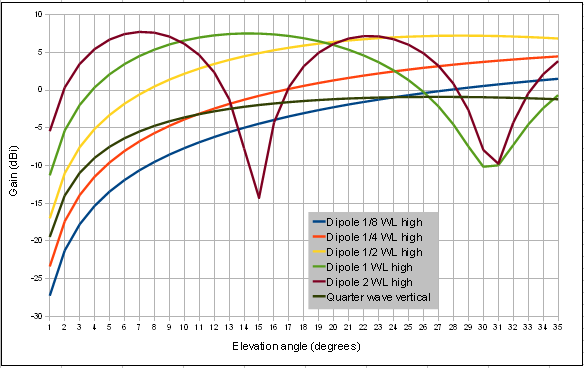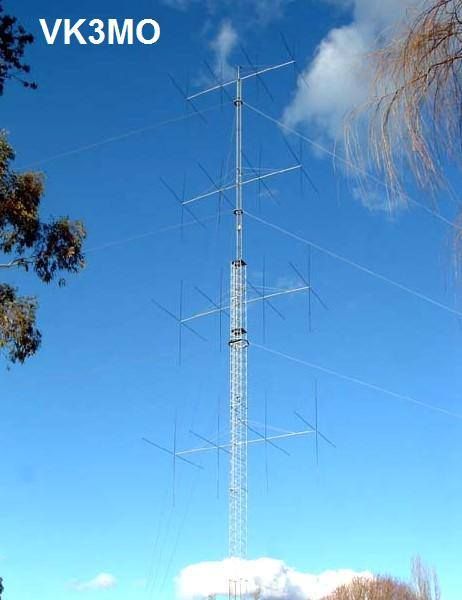I put this in as an answer to a question about stacked antennas but decided it was worthy of being a post on the subject itself.
So the question asked was what is the benefit of stacking antennas?
A description from Steve G3TXQ (SK):
"An HF signal which propagates via the ionosphere will arrive at the receiver site at some angle above the horizon - we call that elevation angle the "Angle of Arrival"(AoA). The AoA depends on many factors. Obviously simple geometry tells us that the closer the Receiver site is to the Transmitter site, the higher the AoA is likely to be; however there are many other factors at play including the effective height of the ionosphere and the number of "hops" the signal takes, which in turn depend on the frequency, the time of day, the season of the year, and the point in the sunspot cycle.
It helps to know the likely AoA for a particular path because if we compare it to the elevation pattern of an antenna it helps us judge how well that antenna might perform over that particular path.
The ARRL undertook a major project in 1993 to tabulate the arrival angles for signals between major areas of the globe using a computer prediction programme called IONCAP. Many thousands of predictions were run for all levels of solar activity, for all months of the year, and for all hours of the day, and the results were presented statistically as the probability that a particular AoA would be experienced."
The full ARRL data set is available on the CD which comes with the Antenna Book.
Consideration 1:
So what you have is that at different distances, and therefore parts of the globe, the angles are different. Nearer DX will come in at a higher angle than more distant DX.
Here are the charts for the UK for various parts of the world. As you can see, the further away you get, the lower the angle the signals are coming in at. For CB concentrate on the 10m band as it's basically the same as 11m.
(Courtesy of G3TXQ, sadly SK)





Consideration 2: We know from antenna modelling of a beam as you increase the height of the antenna the take off angle of the lobe with the biggest gain lowers and we also get some quite severe nulls appearing in the elevation pattern. Once you get to around a wavelength long the gain curve gets dips in it at certain angles. When you get to two wavelengths long it gets multiple dips.
(Courtesy of G3TXQ, SK)

The problem:
So the problem you have is if you put up an antenna 2 wavelengths high to get the most distance you've got -15dB gain for signals coming in from a few hundred miles away. I've experienced this myself in contesting where I've had a yagi up at 60ft on a wind up tower and not been able to hear anything at all on 10m below 1200 miles despite it being the peak of the solar cycle at the time. When you look at the statistics for 10m for Europe which is 100-1200 miles for me all the signals fall into that -15dB null in the gain chart for a 2 wavelength high antenna. So if you're in the USA and you wanted to hear DX from the States you'd have trouble hearing those states fairly close to you. So you put the antenna lower so you can hear DX from the US but then you lose the stuff several thousand miles away.
The solution:
Stacked antennas. By stacking antennas you get the advantages of the gains at the various take off angles you want so you can hear the nearby stuff on one half a wavelength high when the one 2 wavelengths high can't and the one two wavelengths high can still get all that lovely DX from the other side of the world which the one half a wavelength high can't hear.
There's an Australian, Ian VK3MO, who is very prominent on 20m band. He runs a tower with four stacked 20m quads. Each antenna can be used on its own or all antennas can be run together. He can hear a gnat fart on the other side of the planet no matter how bad the conditions. I first talked to him at the bottom of the last solar cycle using 10W and a home made 20m dipole put up as an inverted V with the top just 16ft high.

So the question asked was what is the benefit of stacking antennas?
A description from Steve G3TXQ (SK):
"An HF signal which propagates via the ionosphere will arrive at the receiver site at some angle above the horizon - we call that elevation angle the "Angle of Arrival"(AoA). The AoA depends on many factors. Obviously simple geometry tells us that the closer the Receiver site is to the Transmitter site, the higher the AoA is likely to be; however there are many other factors at play including the effective height of the ionosphere and the number of "hops" the signal takes, which in turn depend on the frequency, the time of day, the season of the year, and the point in the sunspot cycle.
It helps to know the likely AoA for a particular path because if we compare it to the elevation pattern of an antenna it helps us judge how well that antenna might perform over that particular path.
The ARRL undertook a major project in 1993 to tabulate the arrival angles for signals between major areas of the globe using a computer prediction programme called IONCAP. Many thousands of predictions were run for all levels of solar activity, for all months of the year, and for all hours of the day, and the results were presented statistically as the probability that a particular AoA would be experienced."
The full ARRL data set is available on the CD which comes with the Antenna Book.
Consideration 1:
So what you have is that at different distances, and therefore parts of the globe, the angles are different. Nearer DX will come in at a higher angle than more distant DX.
Here are the charts for the UK for various parts of the world. As you can see, the further away you get, the lower the angle the signals are coming in at. For CB concentrate on the 10m band as it's basically the same as 11m.
(Courtesy of G3TXQ, sadly SK)





Consideration 2: We know from antenna modelling of a beam as you increase the height of the antenna the take off angle of the lobe with the biggest gain lowers and we also get some quite severe nulls appearing in the elevation pattern. Once you get to around a wavelength long the gain curve gets dips in it at certain angles. When you get to two wavelengths long it gets multiple dips.
(Courtesy of G3TXQ, SK)

The problem:
So the problem you have is if you put up an antenna 2 wavelengths high to get the most distance you've got -15dB gain for signals coming in from a few hundred miles away. I've experienced this myself in contesting where I've had a yagi up at 60ft on a wind up tower and not been able to hear anything at all on 10m below 1200 miles despite it being the peak of the solar cycle at the time. When you look at the statistics for 10m for Europe which is 100-1200 miles for me all the signals fall into that -15dB null in the gain chart for a 2 wavelength high antenna. So if you're in the USA and you wanted to hear DX from the States you'd have trouble hearing those states fairly close to you. So you put the antenna lower so you can hear DX from the US but then you lose the stuff several thousand miles away.
The solution:
Stacked antennas. By stacking antennas you get the advantages of the gains at the various take off angles you want so you can hear the nearby stuff on one half a wavelength high when the one 2 wavelengths high can't and the one two wavelengths high can still get all that lovely DX from the other side of the world which the one half a wavelength high can't hear.
There's an Australian, Ian VK3MO, who is very prominent on 20m band. He runs a tower with four stacked 20m quads. Each antenna can be used on its own or all antennas can be run together. He can hear a gnat fart on the other side of the planet no matter how bad the conditions. I first talked to him at the bottom of the last solar cycle using 10W and a home made 20m dipole put up as an inverted V with the top just 16ft high.

